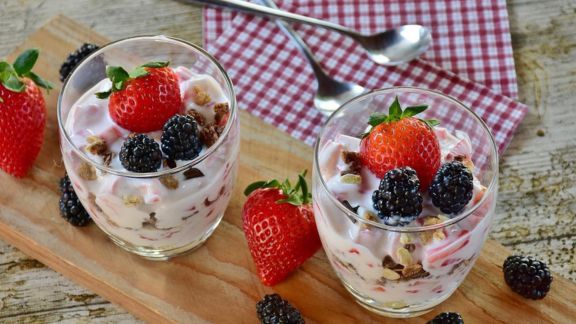10 Healthy Snacks for Nursing Home Residents

Meal times in senior living communities are critical to residents' physical health and emotional well-being. Assisted living menus that offer healthy food choices help residents keep their bodies and minds working their best. Offering nutritious snacks helps older adults maintain their energy levels between meals so they can be active participants in their daily lives.
Read on to discover 10 healthy and delicious snacks for nursing home residents.
Nourishing and Delicious Healthy Snacks
Healthy snacks are a critical element of senior dining that keep your care facility residents feeling their best throughout the day. These 10 snacks deliver essential nutrients for all-day energy levels and long-term health.
1. Fresh Fruit Delights
Fresh fruits aren't only a delicious treat that can satisfy a sweet tooth. They also contain essential vitamins, minerals, antioxidants, and fiber that contribute to health and well-being. Apples, pears, and kiwi can help prevent constipation, while citrus fruits have high levels of Vitamin C that can benefit the immune system. And berries have high antioxidant concentrations, which can help prevent heart disease.
Some residents may have no problem eating whole raw fruit. For others, it should be cut into bite-sized pieces. Fruit packaged in water, with no added sugar, is a good alternative for those who struggle with hard foods or are at risk of choking.
2. Wholesome Trail Mix
Trail mix offers a multitude of benefits to elderly individuals. Dried fruits are full of fiber that helps keep the digestive tract healthy, and nuts and seeds contain healthy fatty acids. When serving trail mix as a snack, it's essential to ensure that nuts aren't served to residents with nut allergies. They can be left out or replaced with seeds. Trail mix is a tasty snack that requires minimal meal preparation.
3. Greek Yogurt Parfaits
Greek yogurt is a good source of protein, which is particularly important for older adults who need sufficient amounts of protein to maintain muscle mass but often fall short of the recommendations. And the calcium, magnesium, and phosphorus in the yogurt help keep bones strong. The probiotics in yogurt also help residents maintain a healthy gut microbiome, possibly reducing symptoms of digestive disorders like irritable bowel syndrome. Probiotics can also reduce diarrhea, bloating, and gas to help residents feel their best.
Small amounts of low-sugar granola contain heart-healthy fiber and turn yogurt into a treat that will delight residents. Adding fresh fruit makes the snack an even healthier choice.
4. Veggie Sticks With Hummus
Veggie sticks are an easy way to increase vitamins, fiber, and antioxidants in residents' diets, as long as they're not on diets that restrict hard and crunchy foods. Hummus makes the veggies more enticing and increases the snack's nutritional profile by adding more vitamins, minerals, and fiber. The combination is satiating, helping residents feel satisfied between meals.
5. Whole Grain Crackers With Nut Butter
Whole grains have lots of health benefits, like improving constipation and helping maintain blood pressure and cholesterol. Eating whole-grain crackers is a simple and tasty way to get those benefits. Eating them with nut butter makes the snack more filling and adds a dose of heart-healthy fats.
6. Cheese and Whole Grain Crackers
Pairing cheese with whole-grain crackers makes for a delicious snack that satisfies hunger by combining carbs, protein, and fat. The calcium in cheese can improve bone density in older adults, protecting them against fractures and osteoporosis. Cheese and crackers is a familiar snack that can be a comfort to many people.
7. Smoothie Cups
Smoothie cups are nutritious snacks packed with vitamins, minerals, and antioxidants. They're a great way to get fruits and veggies in, even for residents who don't usually love eating fresh produce. You can add yogurt or milk to provide calcium and protein. Smoothie cups are a healthy food that's easy to eat and poses a low choking hazard. Serving smoothies at snack time is one way to increase overall food intake for residents who struggle with eating.
8. Avocado Toast
Avocado toast, especially when made on whole-grain bread, is a powerhouse of nutrition. Avocados contain significant amounts of monounsaturated fats. Monounsaturated fats can reduce risk factors for heart disease by lowering blood cholesterol and triglycerides. Avocados also contain lots of vitamins and minerals. The high-fat content helps residents feel nourished between meal times. Whole-grain bread adds healthy carbs that maintain energy levels and a good amount of fiber.
9. Baked Sweet Potato Fries
Sweet potatoes are a healthy food with a good amount of fiber and high levels of beta-carotene. Beta carotene converts to Vitamin A in the body, which supports eye health and may help prevent eye diseases, like macular degeneration, that are common in older adults. It's also an antioxidant that may promote improved cognitive functioning. Serving sweet potatoes as fries makes them fun and easy for residents to enjoy.
10. Dark Chocolate and Nuts
Dark chocolate with nuts is a delicious snack, perfect for residents who enjoy rich foods. Nuts provide heart-healthy fats. Dark chocolate contains heart-healthy fatty acids and powerful antioxidants. It also contains flavonoids, which help residents maintain healthy cholesterol levels and improve their immune function. Dark chocolate also boosts endorphin levels in the brain, helping keep depression symptoms at bay. And it feels like an indulgent treat.
Transform Your Dining Experience With Resident-Centered Tools
Offering proper foods that support your residents' health, taste delicious, and don't destroy your budget can be overwhelming.eMenuCHOICE makes it simple with custom menus, dietitian-approved food items, and technology that streamlines ordering and billing. eMenuCHOICE empowers residents in senior living communities by putting them in control of their meals and including nutritious foods that consistently help them feel their best. It automatically flags foods that contradict a resident's plan of care, such as allergens, to keep them safe while protecting you and your dining services staff against potentially harmful mistakes.
eMenuCHOICE makes it easy for residents to get snacks without accidentally creating revenue leakage. By collecting accurate order info ahead of time, your dining staff will know exactly how much to prepare so no food gets wasted. It captures and tracks orders automatically, and easy-to-use reports help you clear up any billing disputes. And your residents will appreciate being in control of their menu options.



